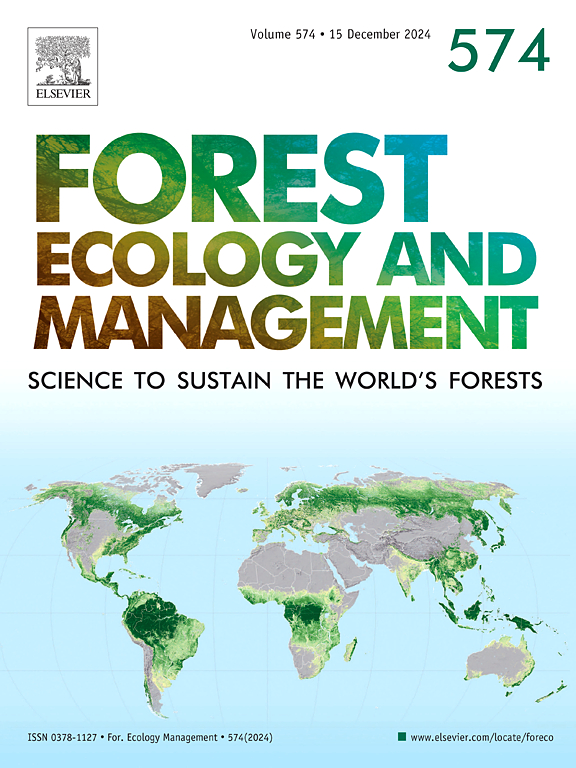Characteristics of soil carbon emissions from different forest types and regions in China
IF 3.7
2区 农林科学
Q1 FORESTRY
引用次数: 0
Abstract
Forest soil is the largest carbon pool in the terrestrial ecosystem, and the soil-to-atmosphere CO2 flux (soil respiration, Rs) is the main link between soil and atmosphere. However, due to the lack of integration of field observations, substantial uncertainties exist in quantifying large-scale soil carbon effluxes, which limit our understanding of the fate of forest soil in a warming world. Here, China’s forest ecosystems were divided into six forest types in six regions, and an integrated soil respiration database (N = 634) was compiled to evaluate soil carbon effluxes by random sampling with replacement. Average annual Rs was 783 g C m−2 yr−1 across China, ranking from the highest to the lowest as follows: East, Southwest, South, Northwest, Northeast and North. Total soil carbon emissions were 1472.6 Tg C yr−1 (1 Tg=1 ×1012 g) in China’s forest ecosystems, and about 69 % from three southern regions (i.e., Southwest, Southern China and Eastern China) and 31 % from three northern regions (i.e., Northwest, Northern China and Northeast). Evergreen needleleaf forest (529.09 Tg C yr−1, 52 %) and evergreen broadleaf forest (343.01 Tg C yr−1, 34 %) were the main sources of soil carbon emissions in three southern regions, while deciduous broadleaf forest (334.36 Tg C yr−1, 74 %) was the main emissions in three northern regions. This study contributes to a comprehensive understanding of soil carbon emission characteristics among different forest types and regions in China and can provide a reference for the selection and combination of tree species in forest management to optimize the forest carbon sink potential.
中国不同森林类型和区域土壤碳排放特征
森林土壤是陆地生态系统中最大的碳库,土壤-大气CO2通量(土壤呼吸,Rs)是土壤与大气之间的主要联系。然而,由于缺乏实地观测的整合,在定量大规模土壤碳通量方面存在很大的不确定性,这限制了我们对全球变暖中森林土壤命运的理解。在此基础上,将中国6个地区的森林生态系统划分为6种森林类型,构建土壤呼吸综合数据库(N = 634),采用随机抽样替代法评价土壤碳通量。全国年平均Rs为783 g cm−2 yr−1,从高到低依次为:东部、西南、南部、西北、东北和北部。中国森林生态系统土壤碳排放总量为1472.6 Tg C yr−1 (1 Tg=1 ×1012 g),南方3区(西南、华南和华东)土壤碳排放总量约为69 %,北方3区(西北、华北和东北)土壤碳排放总量约为31 %。常绿针叶林(529.09 Tg C yr−1,52 %)和常绿阔叶林(343.01 Tg C yr−1,34 %)是南方3个地区土壤碳排放的主要来源,而北方3个地区的主要排放源是落叶阔叶林(334.36 Tg C yr−1,74 %)。本研究有助于全面了解中国不同森林类型和区域土壤碳排放特征,为森林经营中树种的选择和组合,优化森林碳汇潜力提供参考。
本文章由计算机程序翻译,如有差异,请以英文原文为准。
求助全文
约1分钟内获得全文
求助全文
来源期刊

Forest Ecology and Management
农林科学-林学
CiteScore
7.50
自引率
10.80%
发文量
665
审稿时长
39 days
期刊介绍:
Forest Ecology and Management publishes scientific articles linking forest ecology with forest management, focusing on the application of biological, ecological and social knowledge to the management and conservation of plantations and natural forests. The scope of the journal includes all forest ecosystems of the world.
A peer-review process ensures the quality and international interest of the manuscripts accepted for publication. The journal encourages communication between scientists in disparate fields who share a common interest in ecology and forest management, bridging the gap between research workers and forest managers.
We encourage submission of papers that will have the strongest interest and value to the Journal''s international readership. Some key features of papers with strong interest include:
1. Clear connections between the ecology and management of forests;
2. Novel ideas or approaches to important challenges in forest ecology and management;
3. Studies that address a population of interest beyond the scale of single research sites, Three key points in the design of forest experiments, Forest Ecology and Management 255 (2008) 2022-2023);
4. Review Articles on timely, important topics. Authors are welcome to contact one of the editors to discuss the suitability of a potential review manuscript.
The Journal encourages proposals for special issues examining important areas of forest ecology and management. Potential guest editors should contact any of the Editors to begin discussions about topics, potential papers, and other details.
 求助内容:
求助内容: 应助结果提醒方式:
应助结果提醒方式:


